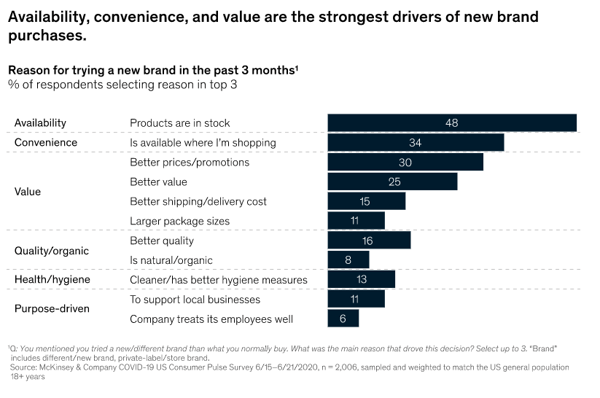We’re now six months into a global pandemic that’s disrupted everything from how we work (from home, if we’re lucky) to what we eat (anything / everything in sight, don’t judge us). At this point, analysts have switched over from predicting consumer behavior changes to analyzing the trends that have emerged.
While most of the more dramatic shifts are well known and understood – the rise of delivery services and the precipitous decline of the airline industry, for example – it is helpful to take a bird’s eye view of consumer behavior to see how motivations have shifted overall and determine how your business can best address those changes.
A recent McKinsey report revealed that 75% of consumers have switched up their shopping habits, whether shopping online instead of in-store or exploring a new brand or retailer for the first time. This signals a challenge to the unwavering loyalty many brands enjoyed before lock-down and endangers the recurring revenue that repeat customers provide.
A deeper dive into the reported reasoning behind these changes cites product availability and convenience as the top factors determining where a consumer will shop. People are looking for ways to simplify their lives and shopping has become one of a small few activities where consumers can exercise some control. This means that brand reputation alone is not enough to keep customers returning to your business, but ensuring product availability and simplifying your buying process can provide ways for you to build a new type of brand affinity.
How Can My Business Meet These New Needs?
-
Ensure Effortless User Experience (UX)
From the moment a customer enters your website, the process of searching, finding, and purchasing an item should be as easy as possible. Focusing on the following aspects of UX will prevent your customers from wasting their time, getting frustrated, and defecting to a competitor’s website.
- Quick Load Time
Your website’s load time is directly related to your website’s bounce rate, a metric that is often used to evaluate website’s effectiveness and authority. Customers have limited patience for high website load times, especially as first time visitors. Aim to have your website load in 3 seconds or less.
- Intuitive Navigation
Now is definitely not the time to experiment with flashy videos or graphics that do not directly aid with product education or navigation. Make sure to feature your navigation and search bars prominently on your homepage. If consumers cannot easily find what they are looking for, they will not stay on your website simply to admire your latest design facelift.
- Simple Checkout
If your customer has made it this far, don’t slow them down with a complex checkout process! Get the information you really need to process the transaction and enlist the help of plugin products that can streamline the process further. Encourage customers to create an account on your website so that preferences are saved for future purchases.
-
Use a Product Feed to Make Recommendations Based on Behaviors and Preferences
Once you’ve streamlined your UX, put your customer data to work by personalizing each digital touchpoint. The data collected from customers both in real time and from previous site visits can be used to power dynamic product recommendation engines.
Product recommendations save a consumer significant search time when populated with sufficient data about the consumer’s preferences. If properly executed, product recommendations prevent the decision fatigue a customer might experience if searching through all product categories, while increasing average order value (AOV). Brands can experience a 31% increase in website revenue from product recommendations.
Learn more about Product Recommendation Engines: [Blog] Mid-Funnel Tactics: Dynamic Product Recommendations
-
Use Smart Retargeting
You might want to write off retargeting ads as a loyalty building tool because sloppy marketers have given them a bad name. The truth is: a wisely executed retargeting campaign can actually save your customers time and effort. That’s exactly what they’re looking for right now!
We’ve found that retargeting efforts that focus on product education and restocking reminders are viewed favorably by customers. 65% of consumers said that they are more likely to buy from a retailer that sends them relevant and personalized promotions. A reminder to buy more concealer a few weeks before a customer is predicted to run out, as Sephora does, demonstrates a level of personalization and utility to a customer whose routine would be interrupted without a steady supply of that product.
This type of thoughtful retargeting ensures that a customer doesn’t even get the chance to buy from a competitor. It makes buying from you, or in this case Sephora, the easiest option.
Learn more about Retargeting: [Blog] 3 Out-of-the-Box Ways to Refresh Your Retargeting
-
Provide Exceptional Customer Service On and Offline
Good customer service may have been a strategic differentiator for companies in the 90s, but now it’s table stakes. While great customer service alone does not guarantee customer loyalty, poor customer service is a death knell. 91% of customers won’t return after a negative experience with your brand. Why should they return when so many other companies are vying for their attention?
You can go the extra mile for customers, both in person and online, by using communication to reassure customers and build trust. With customers prioritizing convenience, it is critical that you address any issues or delays with orders proactively and promote flexible policies. While increased flexibility might lead to more cancellations or greater customer demands, you do not want to be remembered as the company that was difficult to work with. That reputation will haunt you far after things “return to normal.”
Time = Money
The days of automatic brand loyalty are gone, but the McKinsey data reinforces our recommendations for how to attract and keep customers. By taking the time to better understand your target customer in this moment and adapting your strategy to meet consumers’ new priorities – namely product availability and convenience – you’ll be able to build a strong base of returning customers that will follow you into an uncharted future of eCommerce.




